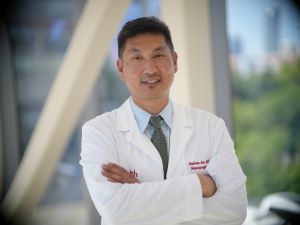
Andrew Jea, MD MBA MHA
Professor and Chair, Dept. of Neurosurgery
Harry Wilkins, M.D., Chair of Neurosurgery
The Department of Neurosurgery at The University of Oklahoma carries a long, storied history within our specialty. Neurosurgery, reflective of The University of Oklahoma, The University of Oklahoma Health Sciences Center (OUHSC), and OU Health, has a spirit of booming clinical growth, high value patient care, academic pursuit, innovation, and leadership.
CLINICAL SERVICE
The neurosurgical service serves a largely rural area in Oklahoma with 4 million people, including 1.5 million children and is the only academic neurosurgical training program in the state. In addition, the clinical practice captures patients from northern Texas, eastern New Mexico, southern Kansas, southeastern Missouri, western Arkansas, and Louisiana. The program at OUHSC addresses important health outcomes and socioeconomic and racial disparities in the state. The hospitals in the OU Health system (> 1,200 beds) including OU Medical Center (OUMC), Oklahoma Children’s Hospital (OCH), and Edmond Medical Center serve the state of Oklahoma and the surrounding region and house the state’s only Level I trauma center, a free-standing children’s hospital, and a National Cancer Institute-designated cancer center. Our robust neurosurgical service and its geographic rural location position us well to develop a strong research program focused on addressing neurological disparities, access to care, and outcomes, while building on a strong basic/translational research arm.
The neurosurgical service covers the entire breadth and depth of neurosurgical procedures. Over 5,500 cases are completed each year at OU Health. There is no reason for an adult or pediatric patient to ever leave the state of Oklahoma for a neurosurgical procedure. Moreover, we take pride in offering singular expertise in the surgical management of uncommon neurosurgical diseases that become a regional and national destination for suffering patients.
DEPARTMENT OF NEUROSURGERY
Overview. A strategic plan for the Department of Neurosurgery focuses not only on state-of-the-art patient care but also on research and research education to establish a bench-to-bedside translational model, to study surgical anatomy & technique, to analyze clinical outcomes, to conduct health services financing, organization, and delivery, and to emphasize quality & process improvement. The Department of Neurosurgery includes a strong clinical program, education program for residents and fellows, neurosciences graduate program, and basic sciences research activities.
Research. Our clinical and research faculty have a deep history of extramural funding. Our Department of Neurosurgery is ranked by The Blue Ridge Institute for Medical Research for its NIH funding level. The recruitment of NIH-funded translational investigators and the development of NIH-funded surgeon-scientists within our own clinical faculty create millions in aggregate funding and boost our national research ranking.
The Neurosciences Graduate Program (NGP). The NGP was initiated as a multidisciplinary, multi-departmental entity over 20 years ago as part of the OUHSC Graduate College, and this program is consistently ranked as one of the top graduate programs at the OUHSC. The NGP has fostered the development of a stimulating neuroscience research environment and includes over 40 affiliated faculty members from 8 different departments and graduate students conducting research in laboratories distributed across multiple departments in the Colleges of Medicine, Pharmacy, and the Oklahoma Medical Research Foundation (OMRF). Students in the PhD program in neuroscience enter through the Graduate Program in Biomedical Sciences (GPiBS), which serves as a gateway into the basic science graduate programs at OUHSC.
It was formally integrated into the Department of Neurosurgery in 2021, where the NGP has continued to flourish.
Residency Training Program. Our resident program is a 7-year program structured into 4-month blocks, with rotations at OUMC, OCH, VAMC, and Mercy Hospital. In addition, trainees rotate at other satellite hospitals to gain exposure to neurosurgery practice in the community. Our residency now includes a complement of 2 residents per year and subspecialty fellows. Residents and fellows operate on/assist in about 5,500 cases a year, ensuring that they are competent in a wide array of neurosurgical techniques including functional neurosurgery, cerebrovascular, spine/peripheral nerve, neuro-oncology, pediatrics, and neuro-trauma.
With the pairing of a research mentor on the first day of internship, attendance at the Research Update in Neuroscience for Neurosurgeons (RUNN) course as a PGY-3, 12 months of semi-protected research time or professional development as a PGY-4, department and education leadership have emphasized research education as a pillar of the neurosurgery residency program. The recruitment of additional faculty with basic science, translational, and outcomes research interests has only expanded research opportunities for residents.
It is a great honor to lead the Department of Neurosurgery at The University of Oklahoma College of Medicine; its clinical, quality, research, and education missions; and its extraordinary, gifted people. I welcome you to learn more about our Department and its destination programs in the following pages. However, if there is more information that we can provide, please feel free to contact us.
Sincerely,
Andrew Jea, MD MBA MHA
Professor & Chair
Department of Neurosurgery
University of Oklahoma College of Medicine